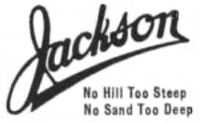Jackson Automobile Company
 | |
| Former type | Automobile Manufacturing |
|---|---|
| Industry | Automotive |
| Genre | Touring cars, roadsters, coupes[1] |
| Founded | 1903 |
| Defunct | 1923 |
| Headquarters | Jackson, Michigan, United States |
| Area served | United States |
| Products |
Vehicles Automotive parts |
Jackson Automobile Company was a brass era auto manufacturer that produced the Jackson from 1903 to 1923, as well as the Jaxon steam car during 1903, and the Orlo only in 1904. All these cars were produced in Jackson, Michigan.
Company Background

The three main partners in the 1902 incorporation of the Jackson Automobile Company were Byron J. Carter, George A. Matthews, and Charles Lewis. Byron J. Carter had previously been a steam-driven press printer who later started a bicycle shop with his father, Squire B. Carter, in 1894. Byron built his first experimental, gasoline-powered car in 1899. After that, he used his steam experience to build a steam powered car, which became the Carter in 1901. George Matthews owned the local Fuller Buggy Company and later built the Fuller, also in Jackson, before it was absorbed by the Jackson Automobile Company. Both Matthews and Lewis were directors of Jackson banks, Matthews of Jackson City Bank, and Lewis of Union Bank of Jackson. Carter convinced the two bankers to support him in forming a company to produce both gasoline- and steam-powered cars.
Jackson
Full production started in 1903 with a single-cylinder engine car that closely resembled the Oldsmobile Curved Dash. The cylinder count in the engines doubled the next year, and doubled again in 1906. Not long after full production started, Carter left the firm to create the Cartercar. He left due to a disagreement with his partners, who did not wish to use the friction drive transmission he had developed. After Carter left, Jackson automobiles lacked any distinct feature, but they were well-built and long-lasting.[2] In 1910, Matthews bought out Lewis, leaving him as the sole remaining partner of the original three. Lewis left to start the Hollier car. Matthews then proceeded to install his sons in the president, secretary, and treasurer positions within the company.
The engines used by the company continued to get larger, with a Northway six-cylinder engine becoming available in 1913, and a Ferro V8 available in 1916. Later cars resembled the contemporary Rolls-Royce. Indeed the company used the phrase "The Car with the Keystone Radiator" in ads.[3]
During the war years, car production at the firm declined by more than half, since the company was producing materiel for the war effort. For 1919, all production was geared to military supplies. Many Jackson dealers at this time converted to Jordan dealerships. When car production resumed in 1920, the cars apparently were not as good as previously. One assembly line worker said that the company engineer "should have raised chickens instead."[3]
The 1921 Princess Coupe was a hit at the Chicago Auto Show,[3] but obtaining credit was difficult during the recession then occurring. In 1923, Jackson, Dixie Flyer, and National merged into Associated Motor Industries. The Dixie Flyer and Jackson were transformed into the National 4-H and 6-51, respectively. These models lasted just a year, and by the end of 1924, Associated Motors was no more, taking all three marques with it.
Jaxon

Byron Carter further developed his eponymous automobile, eventually patenting a 3-cylinder steam engine of 6 horsepower. This became the basis of the 1903 Jaxon automobile. All Jaxons were steam-powered, with the Jackson name reserved for the gasoline-powered cars. There were two models on offer: the $975 Model A riding on a 72" wheelbase, and the $800 Model B on a 7" shorter wheelbase. Ads proclaimed that "steam is reliable and easily understood."[4]
Orlo
This was a companion car to the Jackson that was built in 1904 only. It featured a finned coil radiator that was mounted under the front of the hood.
Duck
There is some debate over whether this is actually a different marque of automobile produced by the company or just a Jackson model. It was also referred to as the Jackson Back Seat Steer. This gives new meaning to the term "back seat driver" because this is the actual location of the steering controls. The company probably introduced the car to see if having a car with the passengers seated in the front seat would be a winning sales proposition. Since this car only was around in 1913, it is not likely that there were many purchasers for such an unusual car.[5]
Notes
- ↑ Imperial Automobile Company. Pawtucket, Rhode Island: The Automobile Journal Publishing Co. 1912.
- ↑ Kimes, Beverly Rae. Standard Catalog of American Cars: 1805-1942 (Iola, WI: Krause, 1996), p.775.
- ↑ 3.0 3.1 3.2 Kimes, p.776.
- ↑ Kimes, p.781.
- ↑ G.N. Georgano, Nick. The Beaulieu Encyclopedia of the Automobile (Chicago: Fitzroy Dearborn, 2000), p.459.
References
- G.N. Georgano, Nick (Ed.). The Beaulieu Encyclopedia of the Automobile. Chicago: Fitzroy Dearborn, 2000. ISBN 1-57958-293-1
- Kimes, Beverly Rae and Clark Jr, Henry Austin. Standard Catalog of American Cars: 1805-1942 (Third Edition). Iola, WI: Krause. 1996. ISBN 0-87341-428-4
| |||||